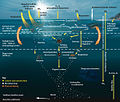Biological pump
Biological Pump
The biological pump, also known as the marine biological pump, is a process that transports carbon from the Earth's surface to the deep ocean. This process plays a crucial role in the global carbon cycle, as it helps to regulate the concentration of carbon dioxide in the Earth's atmosphere.
Overview[edit]
The biological pump is driven by the production of organic matter by photosynthetic organisms in the surface ocean, primarily phytoplankton. These organisms convert carbon dioxide and sunlight into organic matter and oxygen through the process of photosynthesis. When these organisms die or are consumed by other organisms, the organic matter they contain can sink to the deep ocean, where it is sequestered from the atmosphere for hundreds to thousands of years.
Components of the Biological Pump[edit]
The biological pump consists of two main components: the soft-tissue pump and the carbonate pump.
Soft-Tissue Pump[edit]
The soft-tissue pump involves the production of organic matter by photosynthetic organisms in the surface ocean, and its subsequent transport to the deep ocean. This process begins with the uptake of carbon dioxide by phytoplankton, which convert it into organic matter through photosynthesis. When these organisms die or are consumed by other organisms, the organic matter they contain can sink to the deep ocean as marine snow.
Carbonate Pump[edit]
The carbonate pump involves the production of calcium carbonate shells by certain types of plankton, such as coccolithophores and foraminifera. When these organisms die, their shells sink to the deep ocean, where they can contribute to the formation of carbonate sediments.
Role in the Carbon Cycle[edit]
The biological pump plays a crucial role in the global carbon cycle. By transporting carbon from the surface ocean to the deep ocean, it helps to regulate the concentration of carbon dioxide in the Earth's atmosphere. This process is particularly important in the context of climate change, as it can help to mitigate the increase in atmospheric carbon dioxide concentrations caused by human activities.
See Also[edit]

This article is a oceanography stub. You can help WikiMD by expanding it!
This climate change related article is a stub. You can help WikiMD by expanding it.
-
WOA05 GLODAP invt aco2 AYool
-
Vertically integrated anthropogenic dissolved inorganic carbon 1990s (GLODAP)
-
Oceanic Food Web
-
Components of the biological pump 2018
-
Components of the biological pump
-
Size and classification of marine particles
-
Marine connections between the living and the nonliving
-
Fate of DOM in the ocean
Ad. Transform your life with W8MD's Budget GLP-1 injections from $75


W8MD offers a medical weight loss program to lose weight in Philadelphia. Our physician-supervised medical weight loss provides:
- Weight loss injections in NYC (generic and brand names):
- Zepbound / Mounjaro, Wegovy / Ozempic, Saxenda
- Most insurances accepted or discounted self-pay rates. We will obtain insurance prior authorizations if needed.
- Generic GLP1 weight loss injections from $75 for the starting dose.
- Also offer prescription weight loss medications including Phentermine, Qsymia, Diethylpropion, Contrave etc.
NYC weight loss doctor appointmentsNYC weight loss doctor appointments
Start your NYC weight loss journey today at our NYC medical weight loss and Philadelphia medical weight loss clinics.
- Call 718-946-5500 to lose weight in NYC or for medical weight loss in Philadelphia 215-676-2334.
- Tags:NYC medical weight loss, Philadelphia lose weight Zepbound NYC, Budget GLP1 weight loss injections, Wegovy Philadelphia, Wegovy NYC, Philadelphia medical weight loss, Brookly weight loss and Wegovy NYC
|
WikiMD's Wellness Encyclopedia |
| Let Food Be Thy Medicine Medicine Thy Food - Hippocrates |
Medical Disclaimer: WikiMD is not a substitute for professional medical advice. The information on WikiMD is provided as an information resource only, may be incorrect, outdated or misleading, and is not to be used or relied on for any diagnostic or treatment purposes. Please consult your health care provider before making any healthcare decisions or for guidance about a specific medical condition. WikiMD expressly disclaims responsibility, and shall have no liability, for any damages, loss, injury, or liability whatsoever suffered as a result of your reliance on the information contained in this site. By visiting this site you agree to the foregoing terms and conditions, which may from time to time be changed or supplemented by WikiMD. If you do not agree to the foregoing terms and conditions, you should not enter or use this site. See full disclaimer.
Credits:Most images are courtesy of Wikimedia commons, and templates, categories Wikipedia, licensed under CC BY SA or similar.
Translate this page: - East Asian
中文,
日本,
한국어,
South Asian
हिन्दी,
தமிழ்,
తెలుగు,
Urdu,
ಕನ್ನಡ,
Southeast Asian
Indonesian,
Vietnamese,
Thai,
မြန်မာဘာသာ,
বাংলা
European
español,
Deutsch,
français,
Greek,
português do Brasil,
polski,
română,
русский,
Nederlands,
norsk,
svenska,
suomi,
Italian
Middle Eastern & African
عربى,
Turkish,
Persian,
Hebrew,
Afrikaans,
isiZulu,
Kiswahili,
Other
Bulgarian,
Hungarian,
Czech,
Swedish,
മലയാളം,
मराठी,
ਪੰਜਾਬੀ,
ગુજરાતી,
Portuguese,
Ukrainian






